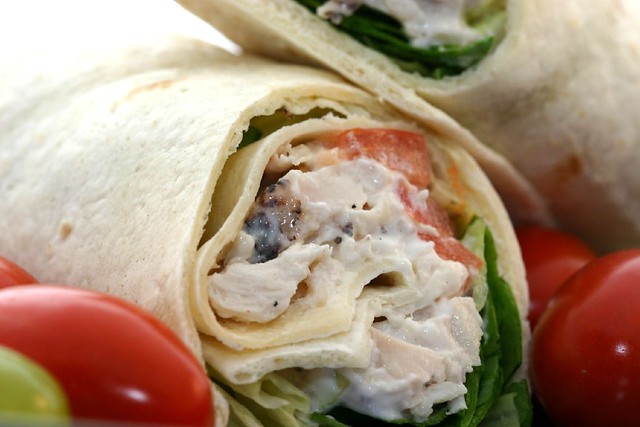The heavy holiday food season has past and you’re craving simpler, healthier foods and recipes. Ordering the following items at a restaurant or deli might seem like a smart way to go, but don’t be fooled—they sound virtuous, but usually are not. Better bet? Cook them at home, where you control the ingredients and preparation.

Chicken Caesar Wrap
For some reason, a wrap always seems healthier than a sandwich—and it can be. The ubiquitous chicken Caesar wrap is a popular choice (what’s not to like about a wrap “sandwich” with a salad built into it, right?). Not so fast. Caesar salad isn’t exactly known for its healthfulness. Romaine lettuce is great and packs healthy nutrients and fiber, but the greens are usually heavily coated with a creamy, high-sodium dressing, topped with Parmesan (more sodium) and sprinkled with a few token pieces of chicken (and who knows how that was cooked, or if it’s processed/frozen/chemically-enhanced chicken). Then there’s the wrapper itself: those giant wraps and tortillas can contribute up to several hundred calories on their own—not even counting the filling. And don’t kid yourself, those spinach and tomato wraps are pretty, but they don’t even come close to providing any actual vegetable goodness (it’s usually just vegetable powder added for color). A whole-grain wrapper is the best choice, but even that cannot save this choice.
Yogurt Parfait
Yogurt, fruit and granola are a simple and yes, quite nutritious breakfast providing protein, some vitamins and minerals, and even some fiber. So what’s wrong with them? Chances are, if you’ve purchased your yogurt parfait at a restaurant or coffee shop, it’s got more fat and sugar (and perhaps sodium) than what you might expect. Granted, some of that sugar is the natural sugar found in dairy products called lactose—but not all of it! Fruit-flavored yogurt has more added sugar than plain or even vanilla yogurt, and the fruit that’s layered inside may also be sweetened. What about the granola? Yes, it provides a tiny amount of fiber (not much is used in a parfait), but it’s also calorically-dense (as well as frequently fat- and sugar-laden). Don’t write off parfaits, just make them at home with low-fat (or fat-free) yogurt (Greek yogurt is a great choice for more protein), fresh fruit or unsweetened frozen fruit (berries are nice), and top with something other than granola for a crunch that delivers more nutrition and less sugar, such as ground flax, chopped nuts, raw oatmeal, wheat germ or a combination of seeds (sesame, chia, pumpkin, and sunflower kernels).
Fish Sandwich or Fish Taco
We hear all the time that fish is healthy for us (health authorities suggest we eat fish twice a week), so it’s no wonder that people fall for this one. Batter-coated and deep-fried fish patties are not what the doctor ordered, however. These small fish patties deliver a hefty dose of fat and calories. Topped with cheese and tartar sauce, the typical fast food fish sandwich weighs in at 400-500 calories and can provide half a day’s sodium as well (in the cheese, the batter, the sauce and yes, the bun). Fish tacos may be a tad better in some ways, but most restaurant fish tacos use the same battered and fried fish portions instead of a more simple grilled fish fillet. And then there’s the shredded cheese, sour cream and tiny amount of veggies are added on. Luckily, you can make a mighty fine fish sandwich or fish taco at home, with a whole wheat bun or small,whole-grain or corn tortilla, a nice piece of baked, grilled or poached fresh fish and a lot of fresh, crunchy veggies on top—a vast improvement (and the same can be done with the tacos, subbing corn tortillas or whole-grain tortillas).